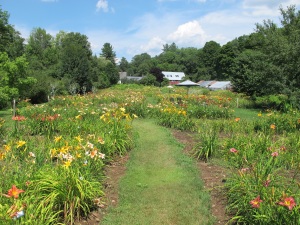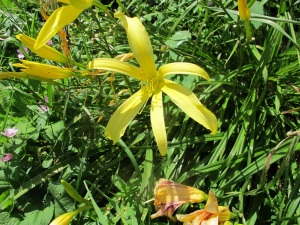Daylilies
Daylilies are wonderful. All beginning gardeners should have several clumps – you essentially can’t kill them. Like many plants, they prefer good rich soil and full sun, but some varieties will survive and thrive most anywhere. They come in a wide range of colors. They have been bred and grown for centuries and by now there are tens of thousands of named varieties. Now is the time when many daylilies are in their prime.
I like to buy flowers in bloom as that way I can better choose the ones that speak to me. So I recently drove to Olallie Daylily Farm in South Newfane, Vermont (www.daylilygarden.com). Chris Darrow, the owner, told me that he has grown at least 2,100 kinds of daylilies, some named varieties, other just bearing numbers from crosses he performed. The farm has about 5 acres of daylilies open to the public, and more daylilies in the 9 acres of field nearby.
Chris Darrow’s grandfather, Dr. George Darrow, was an internationally known daylily breeder, starting in the late 1950’s after retiring from the USDA. For more than 20 years daylilies were his passion. Chris inherited hundreds of varieties from him and has been breeding them himself for over 20 years.
I was interested to learn from Chris that daylilies are easy to breed. Each flower is open for just one day and most are never pollinated. The female part, the pistil, stands up above the male anthers (of which there are usually six), and bees and other insects can visit them and harvest pollen without ever pollinating them. The pollen is not commonly wind-blown often, either. So daylilies seem to wait for us to do the job.
Chris explained that all you have to do is snap off a one of the six anthers and touch it to a pistil. You can self-pollinate a blossom or go to another variety of daylily that you like. Plants that are self-pollinated will not usually produce offspring that are identical to the parent. They may, in fact, have a trait that is emphasized – a tall one bred to itself may produce offspring that are even taller, for example. This allows breeders to develop unique varieties – in several generations.
If you cross two different varieties you might get something that is all new and different, something that is fabulous or something that is absolutely ordinary. It’s a bit like throwing dice – you never know what will show up.
Most daylilies have just 2 sets of chromosomes and are called diploids. Some have 4 sets and are called tetraploids. There are plenty of tetraploid daylilies in existence, and often the blossoms are large and showy. But if you cross a diploid and a tetraploid, you will not get viable seed. So it best if you know your variety name. If you know the name, you can go on-line and look it up at the website of the American Hemerocallis Society (www.daylilies.org). There you can learn if yours is a diploid or a tetraploid. The website has a searchable data base of nearly 80,000 daylilies.
If you want to get seeds, do not snap off the spent flower after it has bloomed. Wait until the green seed pod ripens – it will typically take 40 to 60 days – at which time it will break open. Your job is to pick the pod a little before that happens. If you can squeeze a seed pod and it opens and has dark-colored seeds, it is time to pick it. Chris puts the seed pods from a particular cross into a paper bag. Obviously you will need some sort of numbering and recording system, and a way to identify the parents of the cross.
Daylily seeds need to be cold stratified before planting. This is, essentially, mimicking a winter. Most breeders put seeds in a refrigerator for a minimum of 4 to 6 weeks. Chris Darrow wraps his seeds in moist paper towels for a month starting in February.
To germinate the seeds, Chris Darrow plants them in 32-cell flats in a 60-40 mix of Pro-Mix starting medium and Moo-Doo brand composted cow manure. He puts the seed trays in an unheated greenhouse and lets them warm up slowly. He told me that daylilies are sporadic germinators – seeds might start growing in a week or in a month. It takes 3 years for most daylilies to go from seed to blossom.
If you want to learn more about daylilies, you might want to join the American Hemerocallis Society for $25 a year. That will entitle you to 4 issues of their magazine and a way to connect with other daylily fans. There are regional and national meetings, too.
If you develop a daylily that you think is special, you can register the name with the American Hemerocallis Society for $20. Go to their website, fill out the form, and send it in with a photograph. This can be done on-line or by mail.
Chris’ grandfather lived to be 94 years old. Chris thinks part of Dr. George Darrow’s longevity was his desire to live another year to see what new daylily hybrids blossomed and what they looked like. Maybe that will work for me. I started crossing daylilies last week!
Henry Homeyer is a gardening consultant and author. His website is www.Gardening-Guy.com. You may reach him at henry.homeyer@comcast.net or P.O. box 364, Cornish Flat, NH 03746. Please include a SASE if you want a mail response.





